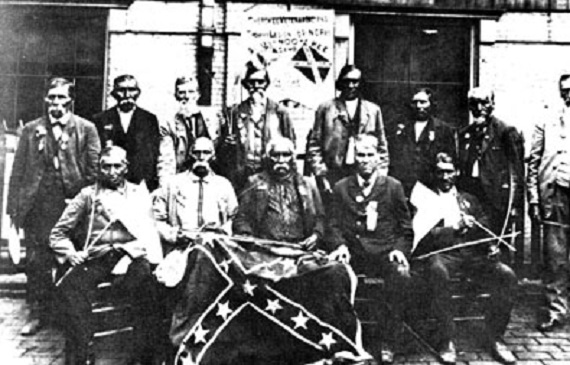A review of The Confederate Cherokees: John Drew’s Regiment of Mounted Rifles by W. Craig Gaines (LSU Press, 2017).
When most people think of Confederate Cherokees, the name Stand Watie immediately comes to mind. This book is not about Stand Watie’s troops but about John Drew’s Regiment of Mounted Rifles. It is also not so much about Confederate Cherokees as it is about one group of Cherokee against another.
The Cherokee were one of the “five civilized tribes” of the Southeast. They had their own alphabet (created in 1821 by Sequoyah (George Guess)), their own newspaper in both Cherokee and English (the Cherokee Phoenix), and their own capital (New Echota, which still exists as a State park in North Georgia). White settlers, though, continually pressured the State and Federal governments to remove the various Indian tribes in the Southeast.
The first Cherokee to leave for the Indian Territory (modern day Oklahoma) removed voluntarily and were called the Old Settlers, or Western Cherokee. Those left behind in the Southeast were divided. The Cherokee Ridge party or Treaty party, headed by Major Ridge, wanted a treaty with the United States to obtain new lands. Chief John Ross was the elected leader of the Cherokee and wanted to stay on Cherokee lands. The Ridge party reluctantly signed the Treaty of New Echota and left for Oklahoma. The Ross party opposed the treaty and was forced out by State and Federal troops to travel on the “Trail of Tears”.
Once in the Indian Territory a blood feud broke out. Major Ridge, his son John Ridge, and Elias Boudinot, a nephew, were murdered. Ridge’s nephew Stand Watie, brother of Elias Boudinot, was one of the few Ridge leaders to escape. This internal struggle was mainly about who signed the treaty of removal. After a series of murders between the sections, finally in 1846 the Old Settlers, the Ridge party, and the Ross party signed a formal treaty in Washington, D.C., ending the internal war.
This brought about a successful building effort within the Cherokee Nation. Whole towns, schools, churches, and homes were built. Businesses were started and promoted. The Ross party held the control of the Cherokee government because they were in the majority. This did not set well with the Ridge party, who objected to the Ross dominance of the Cherokee government. Watie even formed a military unit for protection from the Ross party.
When the Civil War broke out, the Cherokees were surrounded by partisan sides. To the north was the Union State of Kansas; to the northeast the border State of Missouri; to the east was the Confederate State of Arkansas; to the south were the pro-Confederate Choctaw Nation and Creek Nation; further south was the Confederate State of Texas; and to the west were the Plains Indians. The Union forts were abandoned or turned over to the Confederates.
Chief Ross sent delegates to an Indian council to encourage neutrality and to develop plans for all Indians to take advantage of The War to strengthen Indian sovereignty. But they were outmaneuvered by Confederate Commissioner to the Indian Nations, Brig. Gen. Albert Pike, who signed treaties with pro-Confederate leaders. The Cherokee were now surrounded by Confederate tribes.
Finally the Cherokee met and agreed to join the Confederacy. Although Watie was already a colonel, he sought to raise a regiment for the Confederacy, which was granted. But Chief Ross also raised John Drew’s Regiment of Mounted Rifles, which is the subject of this book. Once again political considerations were foremost. Although most of this unit were nominally Confederate, they appeared to want to be neutral and join the Northern missionaries who were their friends.
Gaines has drawn upon a vast assortment of Oklahoma history publications to flesh out his book, and includes a large bibliography. Along with pictures of the main participants he incudes a membership list of the regiment. The sole map is of the battle of Pea Ridge. Gaines presents a Confederate regiment which never really wanted to be Confederate.
We watch it slowly join Union lines and dissolve before its one-year enlistment expired. It was the only Confederate regiment to have almost its entire membership desert to the Union. During The War the Cherokee lost about one-third on both sides. This regiment and Watie’s were faced with the daunting task of reconstructing the Cherokee Nation before Indian lands were opened to white men for the State of Oklahoma.








My grandfather was a scot for the army
His name is Jeanne turner senior Cherokee Indian of Abbeville Louisiana my grandmother’s name was Melanie brasher Turner that was he wife And they were in theTears trailer I’m trying to findThere Rollnumber Are anything I can get on them My mother Was Agnes Turner Connor She married Joseph CB Connor of Abbeville Louisiana